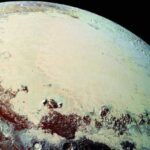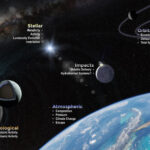In December 2023 and February 2024, NASA’s Juno spacecraft made extremely close flybys of Jupiter’s volcanic moon Io, getting within about 1,500 km (930 miles) of the surface and obtaining the first close-up images of the moon’s northern latitudes. Planetary scientists have now transformed the images collected during the flybys into animations that highlight two of Io’s most dramatic features: a mountain and an almost glass-smooth lake of cooling lava called Loki Patera.
The JunoCam instrument aboard NASA’s Juno spacecraft imaged Io, the most geologically active body in our Solar System, on February 3, 2024, from a distance of about 7,904 km (4,911 miles). Image credit: NASA / SwRI / MSSS.
“Io is simply littered with volcanoes, and we caught a few of them in action,” said Juno’s principal investigator Scott Bolton, director of the Space Science and Engineering Division at the Southwest Research Institute.
“We also got some great close-ups and other data on a 200-km- (127-mile-) long lava lake called Loki Patera.”
“There is amazing detail showing these crazy islands embedded in the middle of a potentially magma lake rimmed with hot lava.”
“The specular reflection our instruments recorded of the lake suggests parts of Io’s surface are as smooth as glass, reminiscent of volcanically created obsidian glass on Earth.”
Maps generated with data collected by Juno’s Microwave Radiometer (MWR) instrument reveal Io not only has a surface that is relatively smooth compared to Jupiter’s other Galilean moons, but also has poles that are colder than middle latitudes.
During Juno’s extended mission, the spacecraft flies closer to the north pole of Jupiter with each pass.
This changing orientation allows the MWR instrument to improve its resolution of Jupiter’s northern polar cyclones.
The data allow multiwavelength comparisons of the poles, revealing that not all polar cyclones are created equal.
“Perhaps most striking example of this disparity can be found with the central cyclone at Jupiter’s north pole,” said Juno’s project scientist Dr. Steve Levin, a researcher at NASA’s Jet Propulsion Laboratory.
“It is clearly visible in both infrared and visible light images, but its microwave signature is nowhere near as strong as other nearby storms.”
“This tells us that its subsurface structure must be very different from these other cyclones.”
“The MWR team continues to collect more and better microwave data with every orbit, so we anticipate developing a more detailed 3D map of these intriguing polar storms.”




